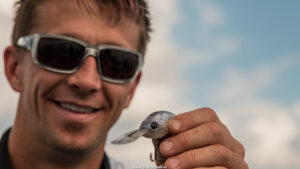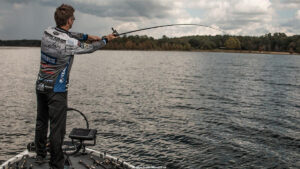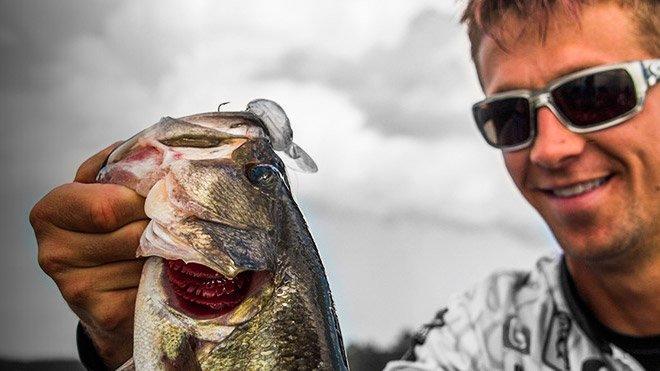Bass anglers are often under the impression that gin-clear water means one thing— spinning gear, light line and subtle presentations. Heck, you can’t really blame us. That’s what many of us were taught growing up and it works a large percentage of the time. So why change?
Elite Series pro Chad Pipkens doesn’t always follow the age-old rules of bass fishing. He’s a powerhouse when it comes to clearwater fishing and believes cranking to be a widely overlooked technique. Although he still fools these wary bass on finesse gear at times, a lot of his biggest and most memorable catches come on crankbaits.
A proactive approach leads to efficiency
Eliminating dead water is a major factor in bass fishing. It’s tempting to imagine a big bass sitting on every piece of good-looking cover, but unfortunately that’s not reality. In order to quickly develop a productive pattern, Pipkens uses a crankbait to take matters into his own hands.
“Popular clearwater techniques such as jerkbaits, drop shots and shaky heads relinquish a lot of control to the bass,” Pipkens said. “They’ll catch fish, but you’re relying on the fish to come to the bait. Crankbaits, however, allow you to bring your lure to the fish and, in a way, force them to react. So when I’m looking for a pattern in clear water, you can be sure I’ll have a crankbait tied on because I can cover water quickly and find the most active bass in a given area.”
Did you know? Pipkens won the 2014 B.A.S.S. Northern Open on Lake St. Clair and clearwater cranking played a major role in his victory. In fact, every bass he weighed-in was caught using this technique.
Just as he’d bang a squarebill into cover in dirty water, Pipkens uses a very similar approach in clear water. He has most of his success by making repetitive casts to very specific pieces of cover. Even if the bass aren’t actively feeding, he believes the “irritation factor” can play a big role in drawing strikes from lethargic bass.
“It can be tough to make inactive, clearwater bass bite with traditional tactics,” Pipkens said. “You can wiggle a drop shot in a bass’ face for what seems like an eternity without getting a bite. But if you make repetitive casts with a crankbait and consistently deflect the lure off of nearby cover, there’s a good chance you’ll irritate the fish enough to where it can’t stand it anymore.”
Focus on the high-percentage areas
Although clearwater cranking can be incredibly effective this time of year, it’s still very important to understand when and where to utilize the technique. Because many late-fall and early winter bass are actively moving to and from shallow water to capitalize on migrating forage, Pipkens makes a concerted effort to target strategic ambush points the bass are likely to use for feeding purposes.
- Grass points— “Points and small turns in submerged vegetation are excellent places to start your search,” Pipkens said. “The bass are filling their bellies for the upcoming winter, so they’ll use these irregularities to hide from shad as they move in and out of the creeks. I like to find grass points very close to creek channels because they act as natural stopping points for both the bass and bait.”
- Windblown points— Cranking windblown points in clear water is a safe bet throughout the entire year, but this pattern is often at its best right now. Pipkens starts by picking a large creek and focusing his efforts on primary points adjacent to deep water. If he’s unable to get bit, he’ll move further into the creek and begin dissecting secondary points. Make sure to pay close attention to where you’re getting bites because this can be a very simple pattern to duplicate throughout the entire lake.
- Rock— “The type of rock you need to target will vary depending upon your geographic location,” Pipkens said. “On northern fisheries, you’ll probably have more success cranking larger, broken-up chunk rocks leading into the backs of creeks. If you’re a southern angler who frequents highland reservoirs, I suggest spending some time locating a healthy mix of chunk rock and pea gravel in the same types of areas.”
- Standing timber— We all dream of having access to fisheries with acres upon acres of standing timber and the reason is pretty simple— it’s prime bass habitat. Pipkens believes this type of cover is perfect for clearwater cranking throughout the entire year, but instead of just picking a row of trees and chunking a crankbait he looks for timber fields leading into pockets with a moderate depth change nearby. These areas often act as funnel points for migrating bass and forage, making them high-traffic areas with a solid population of bass, even when the bite gets tough.
Important crankbait characteristics to consider

Selecting the “correct” crankbait on the water can be a bit overwhelming at times. When you open your tackle boxes and have dozens of different colors, shapes and sizes from which to choose, it’s tough to make up your mind and have confidence in your decision. Fortunately, you don’t need to get too carried away with your selection process when you’re clearwater cranking.
Pipkens looks for three primary characteristics in his crankbaits.
- Runs true— “When I’m cranking in clear water, I’m almost always burning my crankbait,” Pipkens said. “Remember, you’re looking for reaction bites and you also don’t want to give the bass too long to inspect your crankbait and possibly detect any unnatural features. So I want a crankbait that’s going to run straight at high speeds without spinning-out or kicking on its side. If your crankbait looks like a helicopter down there, the bass won’t touch it.”
- Gets there quickly— Pipkens prefers crankbaits that reach their proper operating depths quickly. Because so much of his clearwater strategy revolves around efficiency, he needs his crankbaits to get down to the strike zone without any issues. If a crankbait doesn’t dive quickly, you’ll waste the better part of your cast before the lure reaches the bass.
- Small body— “Smaller bodies are a big deal in this situation,” Pipkens said. “They’re more natural-looking to the bass, but most importantly when you get a reaction strike, the bass is more likely to eat both hooks. The more hooks you have in that bass’ mouth, the better chance you have of getting it into the boat. For this reason, I use the Damiki DC300 with Gamakatsu round bend treble hooks.”
Be cognizant of your retrieve

Perhaps the biggest misconception of crankbait fishing—whether you’re in clear or dirty water—is the belief that the lure will do the work for you. Sure, you’ll find some crankbaits that hunt throughout the retrieve or kick to the side after colliding with cover, but it’s imperative to actively use both your rod and reel throughout the entire retrieve.
I was recently in the boat with Pipkens watching him crank the Damiki DC300 in clear water and I’ll be honest— “focused” would be an understatement. With every deflection, wobble and turn of his reel handle, he actively analyzed the crankbait’s behavior and was able to develop a productive pattern with ease.
According to him, there are two types of retrieves you should try the next time you get on the water.
- Crank, sweep and snap— “The retrieve I most frequently use incorporates erratic movements and changes of your speed and cadence,” Pipkens said. “I’ll make a long cast with fairly light fluorocarbon, such as 12-pound Sunline Sniper Fluorocarbon, and crank the reel handle pretty hard for four or five rotations. Once the crankbait reaches its maximum depth, I’ll sweep my rod tip in an attempt to make the lure deflect off of cover. More times than not, this slight change in cadence and speed will draw the strike. After I hit something, I’ll pause my retrieve and aggressively snap my rod tip upward. Not only does this get the crankbait away from the obstruction, but it also causes a very quick change of direction.”
- Stop-and-go— This is a popular retrieve method for stained-water cranking, but Pipkens has had a lot of success using it in areas with high visability as well. He never wants the lure to do the same thing twice, so he’ll wind it quickly for a few handle turns and suddenly stop it throughout his retrieve. Because clearwater bass are notorious for “following” and being non-committal, the sudden pause can elicit some great bites— even when the bass has no intentions of eating it. Remember, never rely on the cover to make your lure act erratic. Take matters into your own hands.
The next time you find yourself in clear water, don’t be intimidated. If you can make a point to keep your spinning gear in the rod box and commit your day to a small crankbait, you’ll have a great chance of catching a solid limit of bass.












